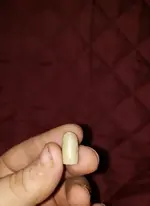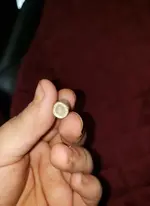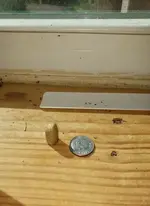I'm truly sorry to have to disappoint this bullet's finder, who was told (by several people) that it is a Confederate Enfield. Unfotunately, this ID-request is NOT "solved." That bullet is neither Confederate nor an Enfield. It is an as-yet-unidentified .32-caliber cartridge bullet for a latter-1800s pistol or rifle.
By definition, an Enfield rifle bullet was made for use in one of the calibers of Enfield rifles or carbines... and ALL of those (at the time of the US civil war and earlier) were above .50-caliber.
The finder's photo shows his bullet sitting next to a US 10-cent coin, which is approximately .70-inch in diameter. The bullet appears to be slightly less than half of the dime's diameter... so the bullet is probably a .32-caliber one.
For anybody who is curious... the name Enfield (for a firearm) comes from the British Armory at Enfield (England), where the British Military designed and produced those firearms and their bullets.
Although many diggers use the name Enfield for almost any rifle bullet whose sides are "slick" (having no body-grooves or rings), in actuality there was no such thing as a .54 Enfield rifle... so calling any .54 bullet an Enfield is incorrect. Although the Confederates produced a slick-sided .54 Minie-bullet for use in their .54 Mississippi and .54 Austrian rifles, the correct term for those bullets would be an "Enfield Pattern" .54 Minie.
Intended ONLY as helpful bullet-ID advice:
Bullet digger John Wess, welcome to TreasureNet and its What-Is-It? forum... the best place on the internet to get unknown objects CORRECTLY identified.

The slick-sided .32 bullet you found has what bullet collectors call a "dish" or "shallow bowl" shaped cavity in its base. Because no .32 (or .36) caliber dish/bowl-base bullet appears in any of the books on civil war bullets, your "soft lead" (pure lead, not a hard lead-alloy) bullet is most likely to be from the latter 1/3rd of the 1800s (1867-1899).










 The slick-sided .32 bullet you found has what bullet collectors call a "dish" or "shallow bowl" shaped cavity in its base. Because no .32 (or .36) caliber dish/bowl-base bullet appears in any of the books on civil war bullets, your "soft lead" (pure lead, not a hard lead-alloy) bullet is most likely to be from the latter 1/3rd of the 1800s (1867-1899).
The slick-sided .32 bullet you found has what bullet collectors call a "dish" or "shallow bowl" shaped cavity in its base. Because no .32 (or .36) caliber dish/bowl-base bullet appears in any of the books on civil war bullets, your "soft lead" (pure lead, not a hard lead-alloy) bullet is most likely to be from the latter 1/3rd of the 1800s (1867-1899).